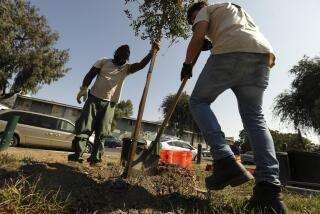Op-Ed: It’s 90 degrees in the shade — have you watered that tree?
- Share via
We expect a lot from the trees we’ve planted in the Los Angeles Basin. They have to tolerate polluted air, excessive heat reflected off buildings and streets, the compacted or depleted soils that are a fixture of urban life, physical damage (trucks, lawn mowers, weed whackers, graffiti) and nature’s seemingly endless influx of diseases and pests. A tough life indeed.
And yet, L.A.’s trees survive. Many thousands of them beautify the streets, gardens and parks of L.A. They soften our concrete corridors, acres of parking lots and the built environment that defines the city.
It is hard to overstate how crucial trees are to our well-being, especially broad canopy trees, such as coast live oak, western sycamore, jacaranda and red-flowering gum. (Sorry, palm tree lovers. The environmental score card of palm trees pales compared to broad canopy tree species.)
Shade from broad canopy trees reduces the urban heat island effect, cooling our streets, vehicles, people, pets and wildlife. These trees also reduce energy costs when properly sited and pruned. According to the U.S. Department of Agriculture, the cooling effect of a single mature, large, healthy tree “is equivalent to 10 room-size air conditioners operating 20 hours a day.” Trees planted on the west or south sides of a building maximize this saving. Trees that shed their leaves in fall help reduce heating bills by allowing the sun’s rays to warm buildings in winter.
Trees are tremendous carbon sinks, absorbing great quantities of carbon dioxide, which helps mitigate climate change and improve L.A.’s challenged air quality. Their leaves and branches capture and channel rain water into the soil, increasing ground water recharge and reducing storm water runoff and flooding.
Trees provide privacy in a crowded city and reduce noise and glare. They enhance views. Trees can increase property values by 5% to 20% and thereby help generate property tax revenues that partly offset the city’s cost in maintaining its street trees.
Trees sustain a wide array of wildlife — birds, beneficial insects, lizards, western gray squirrels — whose habitats are increasingly threatened by urban development. They provide food in the form of flowers, seeds, fruits and leaves, as well as nesting sites and shelter.
Avoid unnecessary pruning. Most trees don’t need to be pruned annually, save for removing diseased, broken, crossing or hazardous branches.
All of L.A.’s trees now face a long, hot summer, on top of the five-year winter drought. July brought temperatures more usual for the hottest Southern California months: August and September. Some thoughtful action right now by property owners — residential, commercial and municipal — will help save many trees and ensure the health of the city’s urban forest.
If you’ve replaced turf with water-thrifty plants, the trees in your yard will need time to adjust to reduced irrigation schedules. During the hottest months and winter dry spells, irrigate your trees once or twice a month, to a depth of two to three feet, by laying drip emitter tubing or a soaker hose in concentric circles under the tree’s canopy, starting about a foot from the trunk, and retain that precious moisture by applying a two- to four-inch layer of organic mulch under the canopy (leave a mulch-free zone around the trunk). This “blanket” also protects the tree’s feeder roots from heat and improves soil structure as it decomposes.
Release your tree from bondage. Stakes and ties installed at planting often bind so tightly that the tree can’t move. This impedes healthy growth and establishment and can even wound the tree. Once the tree stands upright on its own and doesn’t wobble, remove the stakes.
Avoid unnecessary pruning. Most trees don’t need to be pruned annually, save for removing diseased, broken, crossing or hazardous branches. Constant pruning to manage size is a sign that the tree is too big for the location. Consider replacing it with a right-sized tree.
Pruning live tissue is essentially inflicting a wound that takes energy to heal and it may make the trees more susceptible to pests and disease. No more than 20% to 25% of live material should be removed at any one time, even less for mature trees.
And pruning is best done in cool weather, from October to January. Summer pruning reduces the shade we all need, and increases stress on water-deprived trees; spring and mid-summer pruning disturbs birds’ prime nesting season. Best advice: Hire a licensed, certified arborist to trim your trees.
Every day, the trees in the Nature Gardens, just outside the Natural History Museum, offer me and our many visitors the same rewards the whole city gets from its urban forest: a cool patch of shade, a better breath of air, the chance to see a Cooper’s hawk or Allen’s hummingbird perched on high and acorns ripening on a coast live oak. In the heat of the summer, none of us should take those gifts for granted.
Carol Bornstein, a horticulturist and native plant specialist, is the director of the Nature Gardens at the Natural History Museum of Los Angeles County.
Follow the Opinion section on Twitter @latimesopinion and Facebook
MORE FROM OPINION
When it comes to water, do not keep on trucking
L.A. isn’t a suburb. We need to stop planning it like one.
Are we raising a generation of nature-phobic kids?
More to Read
A cure for the common opinion
Get thought-provoking perspectives with our weekly newsletter.
You may occasionally receive promotional content from the Los Angeles Times.









